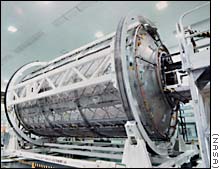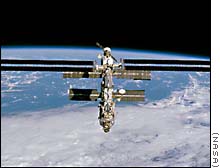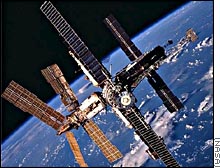Part 2
The Science of the International Space Station
(CNN) -- Sometimes, less is more. Just ask NASA.
The movie "2001: A Space Odyssey" gave audiences an unforgettable
image of what a space station might look like. It was a giant
spinning wheel with artificial gravity. The concept had been around
since the 1950s.
Reality has turned out quite differently. The two current space
stations, Mir and the International Space Station, don't have
artifical gravity and look like anything but giant spinning wheels.
Is there something missing here?
Ask NASA that question and you'll hear an emphatic, "No." The
space agency designed the ISS with the idea of creating an
environment where scientists could study long-term effects of
microgravity on humans, animals, plants, tissue, materials and more.
John Uri is a scientist working with the International Space
Station. He says the research that will be done on the ISS can't be
done anywhere else. "You need that microgravity environment," he
says. "You need it for a long duration of time."
One of the priorities for NASA is to use the ISS to study what
microgravity does to people. Four decades of human space travel show
that it weakens the bones, the muscles and even the cardiovascular
system. Some astronauts experience nausea or have trouble sleeping.
Uri says the goal of this new research is to find ways to make space
a friendlier place to live.
 |
VIDEO |
 John Uri of
NASA comments on experimentation aboard the
International Space Station John Uri of
NASA comments on experimentation aboard the
International Space Station
Play
video
(QuickTime,
Real or Windows Media)
| |
| |
 |
GALLERY |
|
|
| |
 |
MESSAGE BOARD |
|
|
| |
 |
INTERACTIVE |
|
|
| | |
"Some of the earlier things we're going to be studying is
understanding the mechanisms of how those changes actually occur,"
he says. "So far we've observed what the changes are and now we need
to know what the mechanisms are so we can develop counter measures
to prevent those changes."
Another key area of research is biotechnology. One of the
experiments scheduled over the next few months will examine the
growth of protein crystals. NASA says when these crystals are grown
in microgravity, they're larger and it's easier for scientists to
understand how they are structured.
Teresa Vanhooser of the Marshall Space Flight Center says that
has implications for the health of humans here on Earth.
"The protein crystal growth is a breakthrough they've had in
finding cures for diseases and coming up with medicines based on how
a crystal develops or how proteins from a body or from a disease
develop," she says.
Other projects planned for the ISS include:
- A search for better ways to protect people in space from
harmful radiation.
- Studying the growth of tumors in microgravity, which may lead
to better treatments for cancer, diabetes and AIDS.
- Pointing some the station's monitoring devices back toward
Earth to learn more about long-range trends in weather, climate
change, land use, and the health of the oceans.
- Giving astronomers a better platform to study the heavens to
gain more knowledge about the Sun, cosmic rays and the existence
of dark matter.
The International Space Station is not without its critics. They
point out that with an estimated price tag of $100 billion, the ISS
is far more expensive than originally planned. Construction has
fallen way behind schedule. They charge that the Russian-built
sections have not matched NASA's standards for quality. Many
scientists question the need for keeping humans in space, saying
unmanned spacecraft can produce better science at a fraction of the
cost.
Vanhooser believes someday the critics will be proved wrong.
"I think the space program already has lots of spin-offs because
of the research it's done up till now," she says. "The space station
is another step in the direction of learning more. We need to make
sure we continue to learn and that we continue to do the research
and development. I think that's where NASA's strong points are."
The ISS is a work in progress. Construction of the space station
is expected to last until 2006. But it won't take that long to start
conducting the science. Some experiments are already under way, but
the pace really begins to pick up in 2001.
 |
| The
U.S. laboratory module "Destiny" is scheduled to launch
in January aboard space shuttle Atlantis |
| |
"We'll start the year off by launching the U.S. laboratory," says
Uri, "which will be our first facility to conduct large-scale
research. And throughout that year, we're going to be adding
research facilities, adding large numbers of experiments and that
will just continue to grow over the next five or six years."
For now, the International Space Station is in the hands of the
Expedition One Crew. This joint U.S.-Russian astronaut team took
occupancy November 3, marking what's hoped to be the beginning of a
permanent human presence in space.
"I think it's a wonderful step," Uri says. "It's one of those
subtle kind of events. It's not like when we landed on the moon and
everybody was watching."
"When we look back 100 years from now, historically it will be a
very significant event. It's really the day humans became a
space-faring species."
| Chat schedule:
|
The following
online chats are scheduled in conjunction with the
"2001: A Space Prophecy" series (all times
Eastern):
• Wednesday, December
27, 2 p.m.: Dr. Ashwin Ram, president and CEO of
Enkia Corp., will discuss artificial intelligence and
its possible commercial
applications.
• Thursday, December
28, 2 p.m.: Gene Meyers, president of Space Island
Group, will discuss his company's plans for a private
space station.
• Friday, December
29, 2 p.m.: Andrew LePage, physicist and senior
scientist of Visidyne Inc., will discuss the search for
extraterrestrial
life.
| |
RELATED STORIES:
Space
station crew fields questions from CNN.com readers
December
15, 2000
Astronauts
enter space station
December 8, 2000
Astronauts
successfully repair space station wing
December 7,
2000
Miles
O'Brien: ISS is an engineering, geopolitical
marvel
December 7, 2000
RELATED SITES:
International Space Station
NASA
Office of Space
Flight - Mir
NASA's Marshall Space Flight
Center
Note: Pages will open in a new
browser window External sites are not
endorsed by CNN Interactive.
| 





